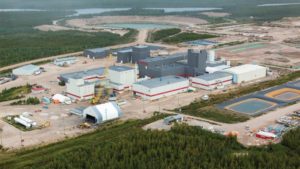
McLean Lake uranium mill in the Athabasca basin of northern Saskatchewan, 22.5%-owned by Denison Mines, (AREVA 70%). Source: Denison Mines Corp.
Denison Mines Corp. [DML-TSX; DNN-NYSE American] said Tuesday December 18 that it has elected to advance its Wheeler River uranium project in Saskatchewan following positive pre-feasibility study results.
Denison is a uranium exploration and development company with interests focused in the Athabasca Basin region of northern Saskatchewan, including its 90%-owned Wheeler River Project, which holds the high-grade Phoenix and Gryphon uranium deposits (on the Wheeler River property).
Denison also owns a 22.5% interest in the McClean Lake uranium mill which is designed to process high-grade uranium ores. It is also the manager of Uranium Participation Corp., a publicly-traded company which invests in uranium oxide and uranium hexafluoride.
In keeping with the decision announced on Tuesday, Denison said the Wheeler River Joint Venture has approved a $10.3 million budget for 2019 (100% basis), which is highlighted by plans to initiate the environmental assessment process as well as engineering studies and related programs required to advance the high-grade Phoenix deposit as an in situ recovery mining operation.
In-situ recovery (ISR) or solution mining involves processing the uranium while it is still in the ground through the injection of catalyzing agents into the ore.
In situ-recovery is only possible in porous geological formations (like sandstone) which are amenable to such a technique. On average, the capital spend needed to put an ISR uranium project into production is less than 15% of the cost to build a conventional hard-rock uranium mine.
Denison’s share of the 2019 budget for Wheeler River is $9.3 million, reflecting its 90% ownership interest. The other 10% is held by Japanese company JCU (Canada) Exploration Co. Ltd.
The pre-feasibility study considers the potential economic merit of co-developing the Phoenix and Gryphon deposits, assuming Phoenix would be designed as an ISR mining operation with associated processing to a finished product occurring at a plant to be built on site at Wheeler River.
Based on the pre-feasibility study plan, first production from Phoenix is expected in 2024, with the development of the Gryphon deposit to follow with first production projected for 2030.
Taken together, the project is estimated to have a mine production of 109.4 million pounds of U3O8 over a 14-year mine life, with pre-production capital estimated at $322.5 million.
Wheeler River is the largest undeveloped uranium project in the infrastructure-rich eastern portion of the Athabasca basin region in northern Saskatchewan. It features a combined indicated mineral resource of 132.1 million pounds of U3O8 at an average grade of 3.3% U308. On top of that is a combined inferred resource of 3.0 million pounds of U3O8 at an average grade of 1.7% U3O8.
On Tuesday, Denison shares rose 1.61% or $0.01 to 63 cents. The 52-week range is 88 cents and 54 cents.
